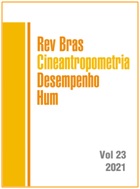Prevalence of global physical activity among young people: an updated systematic review for the Brazil’s Report Card
DOI:
https://doi.org/10.1590/1980-0037.2021v23e82643Abstract
This study aimed to update the review of Brazil’s Report Card on the prevalence of global physical activity (PA) among Brazilian children and adolescents. This systematic review included an electronic search of eight databases (PubMed, Scopus, Web of Science, LILACS, SPORTDiscus, BIREME, Scielo, and Google Scholar) and a manual search of the references of retrieved studies. Studies published in 2018 and 2019 that assessed global PA among Brazilian youth were included. A narrative approach to the results was adopted. The initial search retrieved 1,892 potentially relevant titles (1,244 titles after duplicate analysis), of which 62 (47 different studies) met all the inclusion criteria. Most updated studies were carried out in Southern (40.4%) and Southeastern (25.5%) Brazil. Six studies provided data from national surveys (12.8%), and one study included preschool children (< 5 years old). Ten studies objectively measured PA (accelerometer or pedometer devices). In the updated studies, the overall proportion of young people who were physically active ranged from 9.8% to 79.6%. Three national surveys reported the prevalence of physically active students, ranging from 18.4% to 78.8%. There was an increase of surveys that objectively measured PA and with children under 12 years of age in the 2018 and 2019 studies. However, important research gaps (e.g., variations in the measurement of global PA), even in the same study, should be considered to improve the monitoring and evaluation of global PA in Brazil.
References
Bull FC, Al-Ansari SS, Biddle S, et al. World Health Organization 2020 guidelines on physical activity and sedentary behaviour. Br J Sports Med. 2020;54(24):1451-1462. doi:10.1136/bjsports-2020-102955
The Active Healthy Kids Global Alliance. The Global Matrix 4.0 on Physical Activity for Children and Youth. https://www.activehealthykids.org
Aubert S, Barnes JD, Abdeta C, et al. Global Matrix 3.0 Physical Activity Report Card Grades for Children and Youth: Results and Analysis From 49 Countries. J Phys Act Health. 2018;15(s2):S251-S273. doi:10.1123/jpah.2018-0472
Barbosa Filho VC, Costa RM da, Knebel MTG, Oliveira BN, Silva CB de A, Silva KS. The prevalence of global physical activity among young people: a systematic review for the Report Card Brazil 2018. Rev Bras Cineantrometria E Desempenho Hum. 2018;20(4):367-387. doi:http://dx.doi.org/10.5007/1980-0037.2018v20n4p367
Troiano RP, Stamatakis E, Bull FC. How can global physical activity surveillance adapt to evolving physical activity guidelines? Needs, challenges and future directions. Br J Sports Med. 2020;54(24):1468-1473. doi:10.1136/bjsports-2020-102621
Caspersen CJ, Powell KE, Christenson GM. Physical activity, exercise, and physical fitness: definitions and distinctions for health-related research. Public Health Rep Wash DC 1974. 1985;100(2):126-131. doi:10.2307/20056429
Lubans D, Richards J, Hillman C, et al. Physical Activity for Cognitive and Mental Health in Youth: A Systematic Review of Mechanisms. PEDIATRICS. 2016;138(3):e20161642-e20161642. doi:10.1542/peds.2016-1642
Poitras VJ, Gray CE, Borghese MM, et al. Systematic review of the relationships between objectively measured physical activity and health indicators in school-aged children and youth. Appl Physiol Nutr Metab. 2016;41(6):S197-S239. doi:10.1139/apnm-2015-0663
Karas M, Bai J, Strączkiewicz M, et al. Accelerometry Data in Health Research: Challenges and Opportunities: Review and Examples. Stat Biosci. 2019;11(2):210-237. doi:10.1007/s12561-018-9227-2
Migueles JH, Cadenas-Sanchez C, Ekelund U, et al. Accelerometer Data Collection and Processing Criteria to Assess Physical Activity and Other Outcomes: A Systematic Review and Practical Considerations. Sports Med. 2017;47(9):1821-1845. doi:10.1007/s40279-017-0716-0



